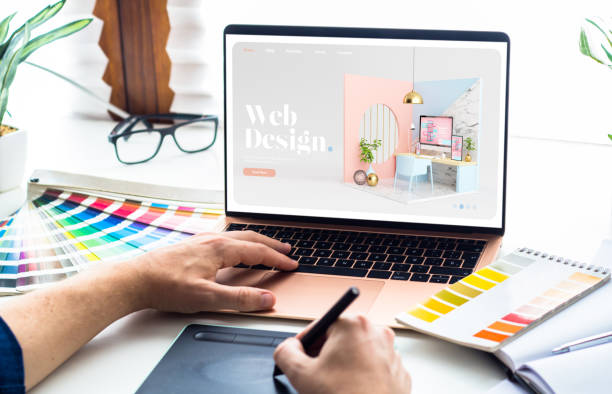Creative Website Design Solutions for Modern and Engaging Internet Sites
In the realm of internet layout, the search of contemporary and engaging options has become progressively crucial for businesses intending to catch customer attention. By integrating strong color design, interactive components, and responsive designs, developers can produce experiences that not only resonate with individuals but additionally enhance brand name identification. The critical consolidation of multimedia web content further enriches these communications, cultivating a much deeper connection with site visitors - las vegas seo. Nevertheless, truth challenge hinges on balancing creativity with functionality-- an exploration that discloses several ingenious techniques worth considering.
Accepting Vibrant Shade Systems
In web style, the critical use vibrant color design can considerably improve individual interaction and brand name identity. By utilizing vivid tones, designers can produce visually striking sites that catch attention and foster a memorable experience. A well-chosen color palette not only mirrors a business's values however likewise stimulates details emotions that can affect individual behavior.
Strong shades can be utilized to lead users' focus to key components such as telephone calls to activity, improving conversion prices. Using contrasting shades for switches and web links can make these components stand out, prompting individuals to interact more easily. A natural shade plan across the site enhances brand acknowledgment, developing a sense of experience and trust fund among site visitors.
Nonetheless, it is crucial to balance bold colors with appropriate white area to prevent frustrating individuals. Efficient use typography likewise matches vibrant shades, ensuring readability while keeping visual allure. Eventually, embracing vibrant color pattern in internet design not only elevates aesthetic top quality yet additionally plays an integral duty in attaining calculated business goals, making it a necessary consideration for modern-day internet growth.

Making Use Of Interactive Components
Interactive components are crucial in modern website design, as they substantially boost individual engagement and create a more vibrant searching experience. By incorporating features such as computer animations, float impacts, and clickable components, sites can urge individuals to explore web content more completely and return for future gos to.

Micro-interactions, such as subtle computer animations when a switch is clicked or a type is sent, can also improve the customer experience by providing instant comments. These little details can make the web site really feel more receptive and active, cultivating a feeling of connection in between customers and the site.
Moreover, gamification components, such as benefits for completing certain actions, can motivate users to engage with the material extra deeply. By thoughtfully incorporating these interactive elements, web developers can develop an unforgettable and engaging on the internet experience that reverberates with individuals and encourages them to return.
Executing Responsive Style
Implementing receptive layout is crucial in today's multi-device landscape, making sure that web sites offer an optimal watching experience throughout different screen dimensions. As customers increasingly access the web through smart devices, tablet computers, and desktops, a one-size-fits-all approach Check This Out is no much longer practical. Receptive design enables for seamless navigation and communication, adapting layout and web content to fit the tool being made use of.
Trick concepts of receptive style include fluid grids, adaptable pictures, these details and media questions. Media questions help with the application of various designs based on the tool's features, such as width, elevation, or resolution, enabling designers to customize the individual experience properly.
Moreover, receptive style improves SEO performance, as internet search engine favor mobile-friendly sites. By executing responsive design, companies not only boost user satisfaction and engagement however additionally boost their reach in an affordable electronic landscape. As innovation proceeds to develop, embracing receptive design has actually ended up being an essential practice for any type of contemporary and engaging site.
Incorporating Multimedia Material
Multimedia web content plays a vital role in producing appealing and dynamic internet experiences that catch users' focus and boost understanding. By integrating text, images, audio, and video, internet sites can supply a richer narrative that interest various discovering styles and choices. This assimilation not only strengthens customer engagement yet likewise help in conveying intricate concepts succinctly.
Including top quality photos and infographics can separate textual web content, making it more absorbable. Video clip tutorials and presentations can provide Recommended Reading thorough insights that fixed material might not fully interact. Audio components, such as podcasts or background music, can also boost the atmosphere of a website, creating a more immersive experience.
Furthermore, the tactical use multimedia can improve SEO efficiency, as internet search engine prefer varied material types, increasing visibility. However, it is crucial to make sure that multimedia elements do not impede web page lots times, as this can lead to customer irritation. By balancing multimedia assimilation with performance factors to consider, internet designers can create visually enticing and functional sites that resonate with individuals, cultivating a much deeper connection and encouraging return visits.
Focusing On Customer Experience

To attain an ideal individual experience, developers should focus on several essential principles. Responsive design is important; websites must adapt perfectly to different tools and screen dimensions. This accessibility makes certain that users can involve with content no matter their chosen platform. Clarity in format and power structure is important. Clear calls to activity, legible typography, and arranged material overview users, minimizing cognitive lots.
In addition, including user feedback right into the layout procedure is indispensable. Normal testing with real customers helps determine discomfort points and locations for improvement, enabling repetitive improvements. Inevitably, prioritizing UX not just elevates user satisfaction yet likewise drives interaction and conversion rates, making it a crucial aspect of modern web style strategies. By placing individuals at the center of style efforts, internet sites can create long lasting, positive impressions that motivate return gos to.
Verdict
To conclude, contemporary internet layout services that emphasize strong shade schemes, interactive elements, receptive design, and multimedia web content considerably enhance individual involvement and complete satisfaction. Prioritizing individual experience via clear designs and continuous comments even more adds to enhanced conversion prices. By embracing these approaches, internet sites can properly astound visitors and strengthen brand name identification, eventually bring about a more vibrant and appealing on the internet presence. The assimilation of these layout concepts is essential for accomplishing modern internet layout objectives.